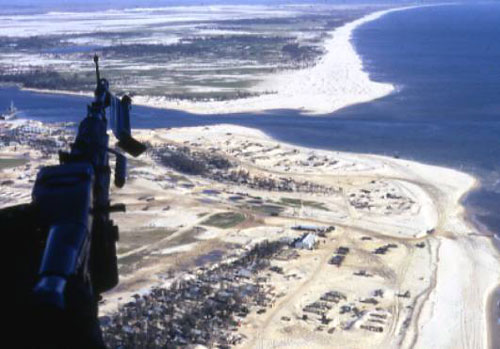
The dangerous narrow channel entrance to the Cua Viet river
Image courtesy of H. W. Hughes
 The dangerous narrow channel entrance to the Cua Viet river Image courtesy of H. W. Hughes |
Not long ago I was reminiscing with a friend about our common experiences in Vietnam. He mentioned that he had found some
solace and emotional healing through reading a number of the stories in periodicals such as Vietnam Magazine. I asked him to
lend me a copy and I was excited to find an interesting article about a member of a Swift Boat crew that I had been stationed with
in Da Nang.
A knot rose in my throat as I read the part where Raul Herrera was asked "Did any Swift Boats capsize while you were there?" He
recalled that at least one boat had capsized in the mouth of the Cua Viet river in November 1967 and that "miraculously the entire
crew was saved." Amazing! It was MY BOAT CREW on PCF-58 that had saved those men on that unfortunate Swift!
|  |
 |
A year before, in 1966, I was nearing my discharge date while serving aboard heavy cruiser Newport News. I had been following the Vietnam war closely and had decided that I wanted to do my part in support of America's effort to relieve the suffering there. I wrote to the Navy and volunteered to extend my service for a year if they would allow me to serve with the Swift Boat squadron recently formed to patrol the coastal and river waters there. |
Shortly thereafter I received orders to report to the PCF (Patrol Craft Fast) school in Coronado, California. While training
with my crew, I was promoted to Boatswain Mate Second Class (E5) and became the leading petty officer for our crew when our
senior engineman sustained an injury. We initially were sent to the Swift Boat coastal division in Qui Nhon, but were then
transferred north to Da Nang where our boat subsequently was assigned duty at the U. S. Naval Support Activity Detachment located at the mouth of the Cua Viet
river, just a few miles south of the Demilitarized Zone.
We were housed in barracks near the river mouth and daily went on patrols along the beaches and adjacent coastal area near the DMZ.
Since there was little commercial traffic north of Da Nang, most of our days were spent searching sampans and junks for weapons and
checking the identification of everyone we encountered on the waterways.
| 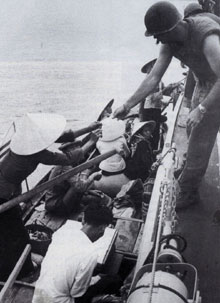 |
The most exciting part about operating from the Cua Viet was trying to safely return the boat and our crew to the base via the treacherous channel at the entrance mouth of the river. The channel was about one-quarter mile long and only about 200 feet wide. On a normal day the swells were usually five to ten feet high, and surfing down the channel in a fifty foot Swift Boat required considrable skill. The real problems occurred during the monsoon season when the waves in the channel were much larger. The challenge of surfing then was comparable to long boarding in Hawaii ... but with five other lives depending on you. It was frightening! |
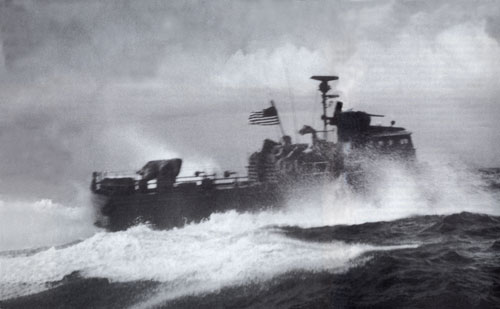 |
On November 30, 1967, while patrolling just south of the DMZ, a suddenly approaching gale force storm surprised us and all three Swift Boats on patrol that day headed back to our Cua Viet base. The waves in the channel entrance were higher than I had ever seen before, and navigating the waves had to be the toughest challenge of my life - to that point. Twice the waves we were surfing tried to turn our Swift sideways and swallow us whole. But by working the twin screws (you can't use the rudders when surfing) we managed to recover and keep the crest of the wave on our stern and the bow pointed straight. |
We surfed past families in their sampans as they too retreated from the turbulent ocean.
We all sighed with relief as our ride on the wave ended in the safety of the calm Cua Viet river.
As we were securing the Swift to the small wooden dock, the other two boats
that had arrived at the base before us, sped past us and headed back up the
channel. The crews waved for us to follow, yelling that sampans were sinking in
the channel. I jumped behind the wheel as Bob Koger threw off the lines and we
headed down the river at full throttle.
| 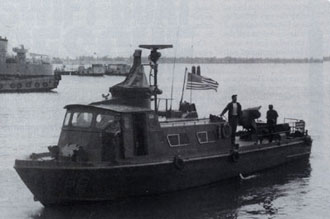 |
As we made it to the river mouth, a chill went through my body as I looked out into the channel, turbulent and strewn with towering dark green white capped waves. |
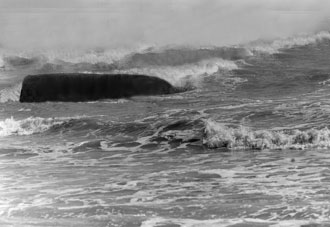 |
My eyes were riveted toward the strange shape of the Swift Boat that had just passed us. It was now upside down
in the middle of the channel. A wave had caught it broadside and flipped it over. Around the hull of the sinking
Swift was its crew of six, plus dozens of drowning Vietnamese men, women and children.
Some were clinging to their swamped sampans and others were disappearing with each violent wave that overtook them.
|
The remaining Swift in front of us, driven by a boatswain's mate named McDonald, headed toward the capsized boat and
started picking up the crew and the Vietnamese civilians. I went to the aft helm and guided the boat to
individuals strewn among the waves and watched as my crew began pulling them
from the water. After we had taken a few people aboard, I looked up and
noticed that the waves were pushing McDonald's Swift dangerously close to the
left side of the channel. He too was standing at the aft helm and the deck
around him was full of the people his crew had rescued, including the crew of
the Swift Boat that had just sunk. It was obvious that within a wave or two,
McDonald's boat would surely get beached. It was time for him to make a
decision. Suddenly I could see his left hand thrust both throttles forward and
with his other hand he quickly spun the wheel to the right.
The events that took place over the next several seconds have replayed in my mind,
in slow motion, for the past 35 years.
|
The waves pounding us were more than 15 feet high and the one that McDonald caught was at least 20 feet. The twin V12s roared as he took the boat full speed into a hard right turn. The 50-foot long Swift Boat looked as small as a bobsled heading high into a banked turn on an Olympic bobsled run. The centrifugal force kept his boat high near the crest of the wave. His crew, plus the crew they rescued, and all of the Vietnamese fishermen and their families fell back into the water as the boat's angle went from 90 to 100 degrees inside the curl. We all thought that he was about to "wipe-out." Miraculously, McDonald was able to stand rigid, gripping the aft helm firmly as the Swift stayed in the curl and exited upright as he reached the right side of the channel. |

|
The joy and thrill of seeing McDonald's boat escape disaster was immediately replaced by the sobering realization that 11 sailors and dozens of Vietnamese now had to be rescued by our lone Swift. Since McDonald was the only man left on his boat he had to abandon the rescue effort and head back to the river mouth. Most of those who were still floating were in a large group. I steered the Swift toward them while my crew went to the bow of the boat to start pulling the survivors aboard. |
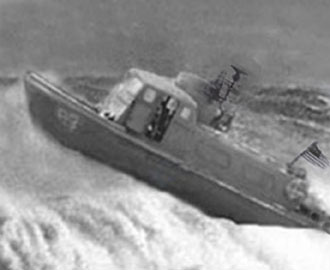
| The huge relentless waves were getting larger and the interval between the waves became shorter. It was now a struggle to keep my bow directed into the oncoming waves. This meant that it was nearly impossible to direct my boat to the people in the water. Just the slightest turn exposed us to the potential of capsizing and losing everyone we'd saved plus my crew and those still in the water. The waves were so steep and our bow so high at times, it felt as though we were standing upright on our stern. As the bow crashed back into the sea with every passing wave, those who were trying to swim close enough to reach an outstretched arm, were pushed away by the wake caused by our falling bow. |
As I struggled to keep the Swift pointed into the oncoming waves while trying
to navigate it toward those still in the water, an Officer from one of the two
crews floated next to my port position at the aft helm. He yelled to me to pull
him from the water but with the waves coming as fast as they were, I couldn’t
chance letting go of the wheel. I yelled and tried to get the attention of
anyone on the bow of the boat, but the noise of the waves drowned me out. To my
terror I discovered that while being distracted by the officer in the water, the
bow of the Swift had drifted to port. The Officer was now a few feet past me and
directly above my port screw. In that split second I realized that in order to
prevent losing my boat in the next wave, I had to turn my stern toward the
Officer, which meant the very real threat of his being sucked into my screws and
chopped to pieces. I knew then that I had no choice but to risk his life. I
yelled to the Officer to push away from the boat, warning him that I was
bringing my stern in his direction. His eyes went wide as he realized what I was
telling him. He screamed at me and pleaded with me to pull him out, but I yelled
at him one last time, "Push away now!" At that, I turned my head away from him
not wanting to watch him being sucked into the screws. My boat was two seconds
from being swamped by the next wave as I sent my port throttle full ahead and
pulled my starboard throttle into full reverse.
It seemed like an eternity as my bow fought off the next wave and slowly
straightened out. Anxiously I quickly looked for the Officer but didn't see him.
I stepped to the side and looked down. There he was, alive, flush alongside with
his arms stretched out along the waterline as though he had suction cups in his
palms. I left the wheel in God’s hands, took hold of a nearby stanchion in my
left hand, and with my right, quickly reached down, grabbed his wrist, and with
strength I have never felt before or since, I heaved him on deck in the blink of
an eye. I took the time to whisper a short prayer of thanks as I jumped back to
the helm.
As our deck slowly filled with dripping wet survivors, a crewman from the
sunken Swift Boat slumped down next to me at the helm and wept. He said, "I was
trying to stay afloat with a little girl and boy under each arm but something
hard struck me in the back of the head and we went under. I lost them both under
the water." I was at a loss for words of comfort for him.
As the last person was pulled aboard I was faced with three major problems:
First: The waves had moved us to the left side of the channel,
dangerously close to the shore.
Second: I had to find a way to turn the boat around without losing
everyone on board
Third: I now had my Boat Officer and the Officers from the other
boats standing behind me.
Each Officer had different directions as to how to turn the boat around. One
suggested that I back the boat into the river mouth. But I dismissed that suggestion
because, with the waves pushing us to the left, at some point I'd have to angle the
Swift and expose her broadside to the waves in order to get into the river mouth.
Another suggested that I take the same action as McDonald did but to start my move
on the back of a wave. My Boat Officer suggested that I take her all the way out of
the channel, into the ocean, turn her around, and then bring her back in. I
pointed out the fact that, if the additional weight and the higher seas didn't
swamp us going out of the channel, they would definitely overtake us if we
surfed back in. If we didn't do something quickly, the next two or three waves
were destined to marry us to the shore. I yelled "Trust me!" and focused on the
next wave.
As we climbed up the raging surf and our bow broke the wave's crest, I thrust the port throttle
forward. We started down the back of the wave just as I flung my wheel hard right,
pulling back full throttle reverse on the starboard engine. Holding our breath, we braced
ourselves as the boat pivoted just in time to catch the next wave flush on her
stern. Thrusting forward with both engines at maximum throttle, we instantly matched the
wave's speed and all hands cheered as the wave picked us up and delivered us safely to the calm
of the river's mouth.
|
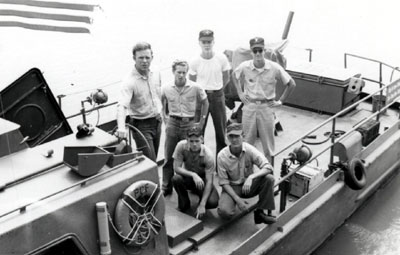 |
Unfortunately, many civilians died that day. But many more would have, had it not been for the actions of the heroic Swift crews. Although no one received medals or commendations, the sailor's reward was knowing that every future generation born to those who were saved that day will be to the credit to the crews of the three Swift Boats that did not hesitate to attempt the rescue in extremely dangerous circumstances. |
There were three Swift Boats lost due to weather while exiting river entrances. Two in the Cua Viet entrance.
And one in the entrance to the Perfume River leading to the capital city of Hue.
The incident related above by Tony occurred on November 30, 1967 in the Cua Viet and resulted in the total
loss of PCF-14. There was very little left of the boat once the sea had taken its toll.
The other boat lost exiting the Cua Viet also capsized due to high seas. This boat was PCF-76 and under the command of
Ltjg Dan Daly
on November 6, 1967
The third boat lost to weather was PCF-77: November 15, 1966
It had been hit by a 30 foot wave, in monsoon weather, with two (2) crewmen and one (1) passenger lost. The Swift
Boat had been attempting to rescue another crewman, from PCF-21, who had been swept overboard by the high
seas, and who was later safely recovered. |
This web site is Copyright � 2002 by Robert B. Shirley. All rights reserved. Click on image to return to the homepage
|